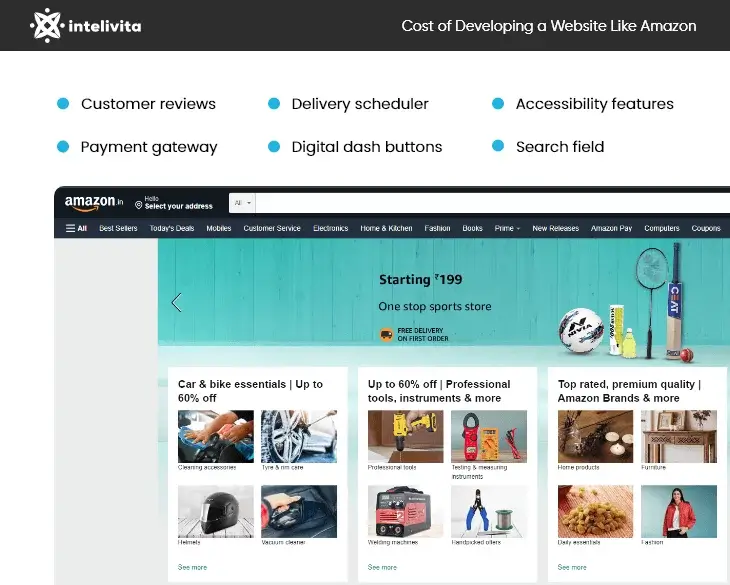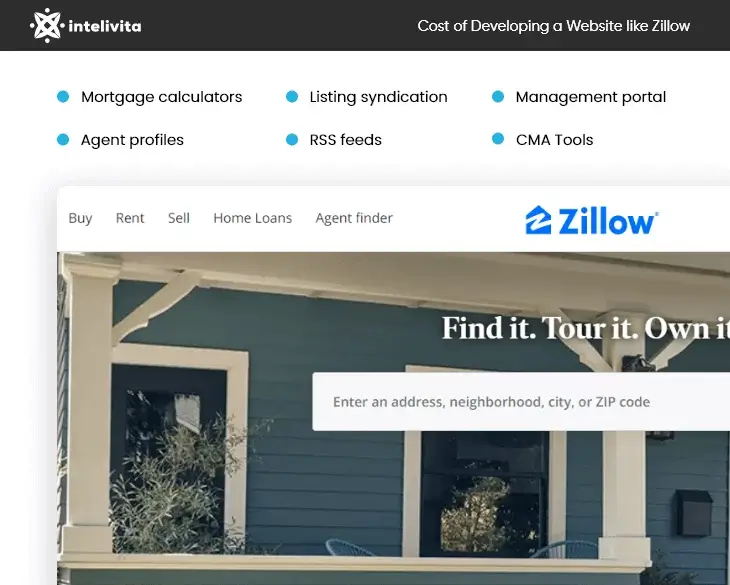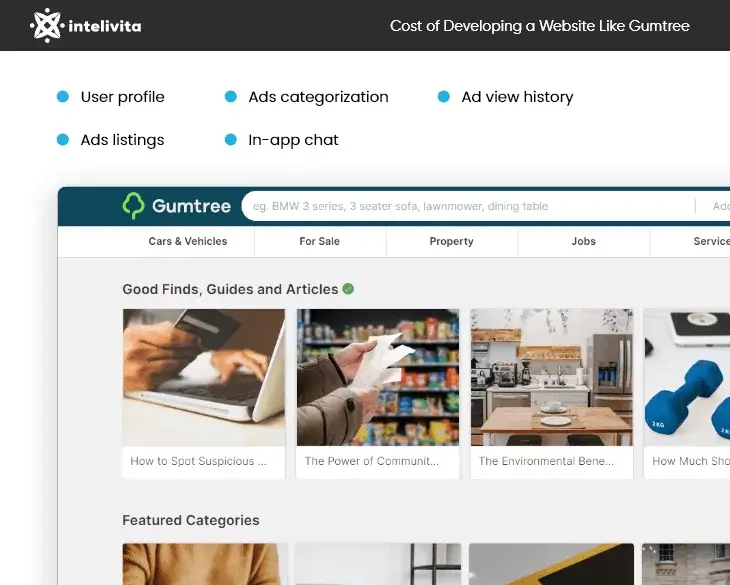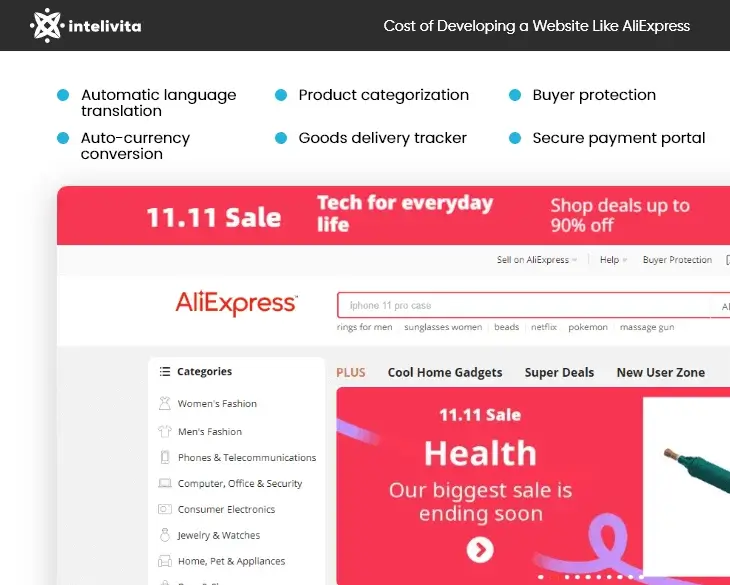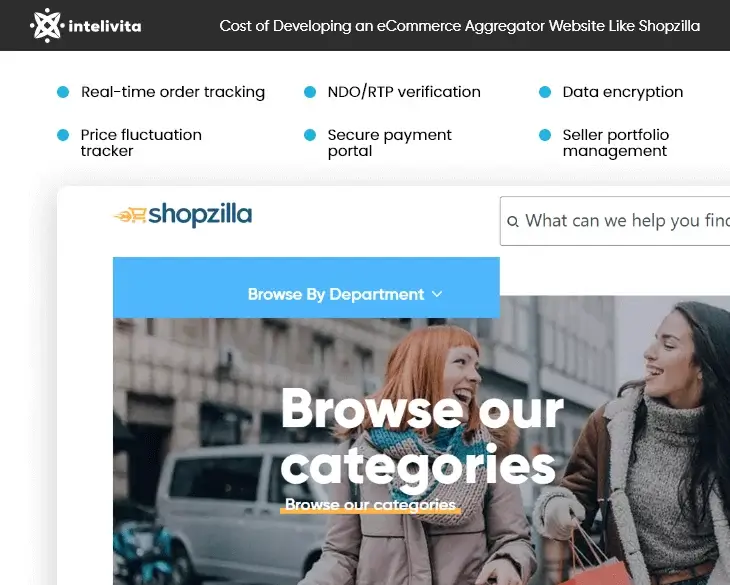Are you a startup founder, serial entrepreneur, or product manager with the question, “how much does an eCommerce website cost?”
Do you want to create an e-commerce website like Amazon or any other reputable platform?
If yes, continue reading this article as we’ll discuss the following:
- What is an eCommerce Website?
- Types of eCommerce solutions
- Reasons to own an eCommerce website?
- eCommerce website development cost
- Case studies of eCommerce Platforms and their cost
- Steps to Creating eCommerce Web Apps
- And more!
You can also go straight to the bonus infographic section if you prefer a visual text experience.
Intelivita provides tailor-made, high-end, & futuristic eCommerce development services to its clients.
Connect with our industry experts today to avail our world-class eCommerce web development services.
Let’s delve right into the nitty-gritty of the article:
What is an eCommerce Website?
An eCommerce website is a platform that allows users to purchase products and services online rather than in a regular brick-and-mortar store.
Alternatively, it can be defined as a platform for entities to find sales online and receive payment for their offerings.
E-commerce sites include Amazon, eBay, Craigslist, Gumtree, etc.
Types of eCommerce Websites
eCommerce platforms can be classified based on:
- Business-to-Business eCommerce platform
- Business-to-Consumer eCommerce platform
- Consumer-to-Business eCommerce platform
- Consumer-to-Consumer eCommerce platform.
Let’s discuss what each entails:
| eCommerce Types | Meaning |
|---|---|
| Business-to-business | This business model creates a platform where business owners can sell to other enterprises.
Statistics suggest that B2B e-commerce sales increased by 17.8% in 2021 alone. Examples of B2B eCommerce platforms are Oracle SuiteCommerce, AliExpress, etc. |
| Business-to-consumer | A B2C or retail eCommerce platform is one where businesses sell to final consumers.
Statista reports that B2C eCommerce is expected to grow at 8% CAGR between 2020-2024. Examples of retail e-commerce websites are Amazon, Netflix, Airbnb, etc. |
| Consumer-to-business | This platform primarily aims to provide an avenue for businesses to hire or purchase services and goods from consumers.
C2B eCommerce affiliate marketing generates 15% – 30% of most brands’ revenue. An example of a C2B eCommerce platform is Upwork. |
| Consumer-to-consumer | A C2C e-commerce platform allows consumers to sell to other consumers.
Statistics suggest that the C2C software eCommerce market will grow from $1.6 billion in 2022 to $2.8 billion in 2023. An example of a C2C e-commerce platform is Etsy. |
Pretty sure you can now place what category your idea falls into. Knowing this is crucial to estimating how much it takes to build an e-commerce website for your startup.
Perhaps you’re wondering, “is it worth owning an eCommerce website?” Yes! And here are some reasons for that:
Why Should You Own an eCommerce Website?
There are multiple reasons to own an electronic commerce platform. However, we’ll let the statistics do the talking.
We’ll consider two sets of statistics: market overview and investment in e-commerce startups. Let’s dig in:
📙 Overview of the eCommerce Sector
- eCommerce sales are expected to grow from $4.89 trillion in 2022 to over $6 trillion in 2023.
- 65% of consumers believe they’ll use eCommerce platforms more in the future.
- eCommerce sales grew by 37% in Latin America last year.
- NASDAQ predicts that 95% of all purchases will be online by 2040.
- With $672 billion, China is the largest e-commerce market in the world.
Pretty sure you know how large the e-commerce market is and the growth therein. Venture Capitalists are also willing to invest in these startups, and here is evidence that proves that:
📈 Investor’s Interest in the eCommerce Sector
- MaxAB, an Egypt-based B2B e-commerce startup, raises $40 million in its Series A financing.
- eCommerce company, Cart.com Inc, raises $240 million for its end-to-end online platform for retailers.
- eCommerce software startup, Instant Commerce, raised 5.4 million euros as seed capital.
Now that you have a concise idea of the opportunities therein and VCs’ interest in the sector. Let’s answer the question: “how much does it cost to make an eCommerce website?”
How Much Does it Cost to Create an eCommerce Website?
A typical eCommerce website costs between $1,500 and $30,000.
To know the exact amount you’ll pay for your eCommerce solution, then you should consider several factors, these entail:
- The type of web builder
- The complexity of the website
- The type of team
- The developer’s country of location
Let’s consider each of these factors in detail:
eCommerce Website Cost Defined by Type of Web-builder
Cost of creating an eCommerce website depends on if you’re creating the website from scratch, using web builders like Spotify, WooCommerce, etc.
Here’s a spreadsheet showing that:
| Web Builder | Cost |
| Custom | $22,000 |
| Shopify | $8,000 |
| WooCommerce | $8,000 |
| Wix | $7,000 |
Although custom websites are more expensive than others, they offer an array of benefits for people in need of a scalable, resilient, and branded platform.
You’ll also need a custom platform if you want to integrate your e-commerce app with your website.
Another method of costing your e-commerce project is based on its complexity.
Cost of eCommerce Website Defined by Complexity
The complexity of an eCommerce platform is its set of user roles, functions, features, and how they interconnect within the website.
The smaller and simpler an application is, the lesser the time needed to create it. Basic apps are less complex since they require fewer features, functions, and user roles. Thus, they’ll require less time.
Here’s a table showing how web development costs stack up per complexity.
| Complexity | Characteristics | Cost |
|---|---|---|
| Simple |
An example of an eCommerce site in this category is ClubKonnect. |
$10,000 |
| Mid-level |
Zenni is an eCommerce site in this category. |
$17,000 |
| Advanced |
Amazon is a popular eCommerce site in this category. |
$28,000 |
Another way to determine e-commerce website prices is by the type of development team. Let’s discuss what this entails:
eCommerce Website Costs Defined by Team Type
The type of team affects the cost of creating an eCommerce website by an essential factor.
The table below shows the cost of developing a site of average complexity:
| Type of Team | Cost |
| Local development company, the US | $180,000 |
| Freelance, the US | $140,000 |
| Outsource, India | $40,000 |
Does each team type seem confusing? Let’s help you make some facts about them.
-
Local Development Company
This is a company based in the same location as the startup. For example, a US startup is outsourcing its e-commerce development to a software agency in the United States. This option usually requires an exorbitant budget, especially for those in high-income nations.
You are a tap away from scaling, automating, and modernizing your business process with Intelivita’s top-rated eCommerce solutions.
-
Freelancers
Freelance teams are independent web builders that handle projects on a per-project basis. These developers are not full-time employees of any organization and usually maintain loyalty to a task in the absence of a more beneficial one. There’s a high risk of a data break with this employment model.
-
Outsourcing Agency
These offshore development agencies handle tasks for startups and large enterprises globally. These agencies provide a cheap way to develop e-commerce websites.
An example of this model is a US company outsourcing its eCommerce development to an Indian-based vendor.
Another factor to consider is the country of location. Let’s also consider this:
Costs of eCommerce Website Defined by Region
Due to the disparity in living expenses from country to country, the price of hiring experts differs–this, in turn, makes costs vary based on the country of residence.
Here’s a table showing the cost of outsourcing per region:
| Region | Hourly Cost |
| The US | $100 |
| The UK | $90 |
| Canada | $90 |
| Australia | $80 |
| Western Europe | $70 |
| India | $35 |
This shows that a way for Startups in high-income nations to lessen eCommerce creation prices is to outsource to developers in another nation.
The most preferred destination for companies like Twitter, Microsoft, etc., is India, as it offers the best cost-quality ratio.
Additional eCommerce Website Costs to Consider
Now that you’ve figured out the answer to the question “how much does an ecommerce website cost?”. Let’s help you with a step-by-step breakdown of some helpful additional costs to consider.
See this as an E-commerce website cost calculator for scaling your solution.
Let’s dig in:
-
eCommerce Web Design Cost
This cost aims to give your website top-notch aesthetics and user experience. The cost here will be expended on layout, brand improvement, and user experience design.
You can use an existing template or custom theme for your eCommerce website design.
Depending on your budget and business goal, you can choose low eCommerce web cost designs or higher-cost designs. Let’s break down what both entail:
| eCommerce Design cost type | Description |
|---|---|
| Lower cost designs | This entails using themes and templates to create stores using DIY web-building platforms.
It involves the use of drag-and-drop page layouts and product pages. You may find free themes on popular web-building platforms like BigCommerce, Shopify, and WooCommerce. However, these templates may seem too familiar to others on the internet–thus, eroding the uniqueness of your brand. Consider customizing website designs to ensure you get the needed result. eCommerce website design cost for template ranges between $2500 and $9000. E-commerce template design customization cost ranges between $9000 – $20,000. |
| Higher cost designs | For a unique design and to give your site a competitive edge, you should opt for a custom eCommerce UI/UX design and functionality.
Although desirable, it increases the cost of building an eCommerce website. Custom eCommerce website development cost ranges from $10,000 and above. |
-
Payment Processing Cost for eCommerce
This is an easily overlooked but important cost to include in your budget. Just because a payment processor is free to integrate doesn’t mean you won’t be paying a fee.
Different platforms offer differing eCommerce pricing. Here are fees processing companies charge eCommerce startups:
| Payment processor | Fees |
| Stripe and PayPal fee for WooCommerce | 2.9% + $0.30 per transaction |
| Stripe and PayPal fee for BigCommerce | 2.4%-2.9% + $0.30 per transaction |
| Shopify eCommerce payment |
2% extra for third-party payment processors |
| Payment cloud | 2.9% + $0.30 per transaction |
-
Search Engine Optimization Cost for eCommerce Website
Every website aims to gain traction and attract the right traffic. This is why you should use the right eCommerce SEO strategy, as it aids the visibility of search engine platforms.
It’s best to map out your SEO strategy from the onset rather than revamping it to accommodate new strategies.
The cost of running SEO for your agency usually ranges from $2500 – $20,000.
-
Additional Dependables and Plugins
There are many services to make your eCommerce platform unique based on the need of your business model.
Here is some idea of eCommerce tools to include in your development plan:
| Additional software | Description |
|---|---|
| Abandoned cart saver | The abandoned cart saver is a tool for sending email invites to customers with an interest in purchasing an item but didn’t complete a checkout process. |
| Customer Relationship Management Software | This is a database that stores and arranges customer information. It helps businesses to understand consumers better. |
| Search field | Search functionality lets consumers find your eCommerce store more efficiently.
Template-based websites offer premium plugins to eCommerce startups in need of this feature. |
-
Content Costs for eCommerce Website
You need the service of a copywriter to curate catchy sales write-ups for your website. The budget allocated to copywriting will be expended on:
- Hiring a copywriter for blog posts and product descriptions
- Creation of videos
- Professionally taken images of the product
The copywriting cost differs widely based on the complexity of your niche, but fees generally range between $100-$1000/day.
Ensure that you have a properly detailed brief to guarantee a great result.
-
Summing Up all Additional E-commerce Website Costs
Your additional monthly fee would range from $100 to $3000/ month for a template/constructor-based website.
But we can break the estimates down so you’ll have a better eCommerce website cost clarity:
| Extras | Small business (Less than 1000 traffic) | Enterprise (More than 1000 traffic/month) |
| Development Timeframe | > 100 hours | > 200 hours |
| Web hosting | $10-$100 monthly | Up to $2000 monthly |
| eCommerce web builder | $20-$300/ month | $3000 monthly + $10,000 eCommerce setup price |
| Copywriter | $1000/month | $5,000 – $50,000/month |
| Payment processor | 2.9% + $0.30 per transaction | 2.4% + $0.30 per transaction |
At the onset of your eCommerce idea, you’ll only require a few. But as traffic gets larger, more changes will be needed.
You’ll need to improve your infrastructure, create a custom solution, adopt a scalable framework, and ensure regulatory compliance.
Also, complex Saas e-commerce platforms require extra add-ons, making them more expensive.
Discuss your eCommerce website idea with us. Our expert eCommerce development consultant will share customized quotes according to your requirement.

Case Studies of Popular eCommerce Websites and Their Cost
Here are the cost implications of creating specific sites from us. The prices might differ slightly based on the nitty-gritty of your idea, compliance laws, and preferred tech stack. Let’s dig in:
Cost of Creating a Website Like Amazon
At 310 million users and with a market cap of over $928 billion, it’s the most successful e-commerce platform ever.
The cost of creating an eCommerce platform like Amazon is $50,000.
Its cost is primarily due to a host of complex features therein, part of which entails:
- Customer reviews
- Accessibility features
- Shopping list recommendations
- Payment gateway
- Buyer and seller profiles
- Delivery scheduler
- Digital dash buttons
- Discounts and coupons
- Search field.
Another we’ll consider is a real-estate e-commerce platform called Zillow.
Cost of Developing a Website like Zillow
Zillow is a real estate marketplace that allows users to find and purchase real estate properties online. The platform currently has over 200 million users and generated a revenue of over $8.1 billion in 2021.
The cost of creating a website like Zillow is $40,000, and the timeframe for development is 6-8 months.
This cost only holds for startups in need of features like Zillow’s which entail:
- Mortgage calculators
- Listing syndication
- Management portal
- Agent profiles
- RSS feeds
- CMA Tools
- MLS feeds.
Another website we’ll use as an example is Gumtree. Let’s discuss this.
Cost of Developing a Website Like Gumtree
Gumtree is a platform offering classified ads to companies and individuals selling goods, services, and jobs based on geographical area. It’s estimated that there are over 1.8 million ads on Twitter.
The cost of creating a web app like Gumtree is $40,000, and the timeframe for project completion is between 4-6 months.
Features in the Gumtree website entails
- User profile
- Ads listings
- Ads categorization
- In-app chat
- Ad view history.
Cost of Creating a Website Like AliExpress
The cost of creating a web app like AliExpress ranges from $50,000 – $90,000, with a timeframe to complete development being about 6-9 months.
AliExpress is an eCommerce platform for businesses to make purchases online from manufacturers in China and have them delivered to their chosen location.
Features in AliExpress are:
- Automatic language translation,
- Auto-currency conversion
- Secure payment portal
- Product categorization
- Buyer protection
- Goods delivery tracker.
Cost of Building an eCommerce Aggregator Website Like Shopzilla
The cost of creating an aggregator website like Shopzilla is $60,000, and you’ll need a timeline of 6-8 months for development.
What’s an aggregator website? It’s a platform that collects data from other platforms and displays it on its own for page viewers to see. In the case of eCommerce aggregators, they display prices from other eCommerce platforms, allowing you to opt for the most desirable.
As in the case of Shopzilla, the features created on the site are:
- Real-time order tracking
- Price fluctuation tracker
- NDO/RTP verification
- Secure payment portal
- Data encryption
- Seller portfolio management.
Now that you’re aware of e-commerce prices for developing a range of websites, you can better estimate the cost of creating your solution.
Steps to Developing an eCommerce Website
To create a solution with maximum impact on your target audience, it’s best to follow these steps to the letter:
Step 1: Discovery Phase
The discovery phase costs about 20-30% of overall e-commerce development cost.
The discovery phase is a research stage, where the Project manager and Business analyst outline client requirements, target audience, business goals, and expected milestones. The CTO here maps out the website’s architecture and allocates tasks to each team member.
Sub-stages in the discovery phase are:
| Aspects | Description |
|---|---|
| Market Analysis | This step entails estimating market readiness for a product, business trends, and potential impact of the site.
According to CB Insights, 42% of businesses fail due to a lack of readily available markets. |
| Target users analysis | This step understudies your product’s potential users to know if they’ll love your offering. The best way for this is by first developing an MVP. |
| Competitor analysis | This step understudies competitors to highlight what works for them, their strategy, and how your product differs. The ultimate aim is to identify your ideas’ capacity to outperform competitors.
Fortunly reports that 19% of businesses fail due to high competition. |
| Business goal identification | A PM speaks to the founder to have a detailed knowledge of your startup’s business goal. |
| Cost analysis | Here, you’ll analyze your overall cost implication for product development, maintenance, and other hidden costs.
29% of startups fail because they run out of cash. Thus, it’s imperative to first count the cost before developing. |
Another essential step in e-commerce development is UI/UX design. Let’s discuss this:
Step 2: UI/UX Design
The UI/UX design step is where a designer creates a prototype of the user interfaces on the website. This prototype contains all buttons, icons, logos, features, and designs a frontend developer will need to code.
The UI/UX design step costs 20-30% of the overall e-commerce website price. The exact figure will be determined by the animation, the number of web pages, etc.
To ensure your e-commerce UI/UX design guarantees optimum user experience and retention rate, do the following:
Another critical step is coding and QA. This is the most technical and requires the most time. Let’s dig into that:
| Tips | Meaning |
|---|---|
| Place key elements properly | Ensure that critical features are placed in either the left or center zone. These are thumb-friendly locations for both right and left-handed users. |
| Simple and short checkout process | Long-checkout process can discourage users from completing purchases. Thus, use one typeface, add spacing, use basic color schemes, and make every icon and button clear. |
| Consistency | Maintain visual and functional consistency. It helps give the website a better structure. |
| Easy navigation | An easy-to-navigate platform improves UX. Ensure that every icon is suggestive of its purpose. |
Step 3: Coding and QA Phase
This phase is the most cumbersome development step. It’s a no-brainer that this phase is the most expensive and time-consuming.
The average price of this step is 50%-60% of the overall e-commerce development costs.
The coding phase is a software system design where frontend and backend developers write codes in a chosen tech stack, to create features and functionalities for the website.
The coding phase is in two steps:
-
Frontend development
Here, a frontend developer creates the User Interfaces per UI/UX design, where page viewers can interact with the website and view available features. Developers here create the part of the website that page viewers see.
-
Backend development
Here, a backend developer creates the server-side framework where clicks from the frontend can interact with the server and perform core operations. Developers here create the parts users don’t see on the platform.
Once both aspects of development are done, a QA test will test the solution to ensure that it meets both technical and business requirements.
Step 4: Product Launch and Feedback
The objective of creating your product is not complete until you launch.
This stage entails purchasing a hosting platform, a domain name, SSL encryption, and other tools needed to maintain your web app online.
Also, when the product is online, you’ll require a budget to adjust per user feedback. Feedback is essential for scaling into a full-service product if your product is an MVP.
The cost of this step ranges between 10%-30% of the overall web development cost.
Interested in Creating an eCommerce Website?
Now that we’ve answered the question: “how much does it cost to build an e-commerce website?” Let Intelivita help you get started.
We help Startups and Large Enterprises create resilient, scalable, and quick-growth e-commerce platforms.
Think we’re just bluffing? Then check out testimonials from clients and our portfolio of past projects.
We also outsource web developers if you want to keep your product’s development processes in-house.
Bonus Infographic
Here’s a summary of our detailed guide “How Much Does an E-commerce Website Cost,” learn about the facets of the development and pricing of an eCommerce Website.

